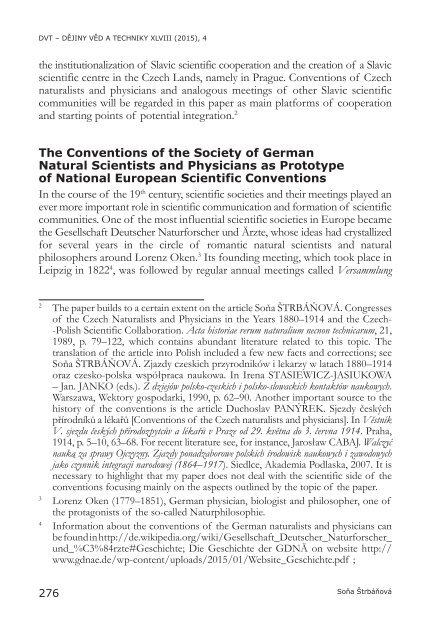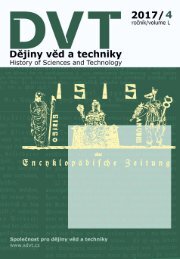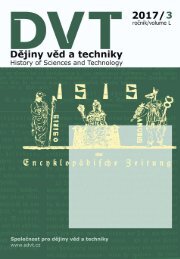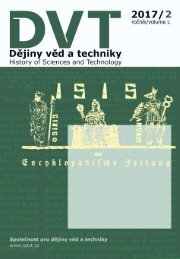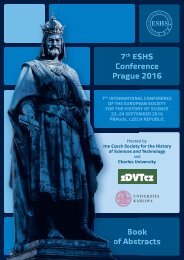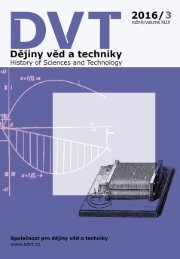Dějiny věd a techniky 2015, 4
Číslo je věnováno 7. mezinárodní konferenci Evropské společnosti pro dějiny vědy, která se konala 22.–24. září 2016 v Praze.
Číslo je věnováno 7. mezinárodní konferenci Evropské společnosti pro dějiny vědy, která se konala 22.–24. září 2016 v Praze.
Create successful ePaper yourself
Turn your PDF publications into a flip-book with our unique Google optimized e-Paper software.
DVT – DĚJINY VĚD A TECHNIKY XLVIII (<strong>2015</strong>), 4<br />
the institutionalization of Slavic scientific cooperation and the creation of a Slavic<br />
scientific centre in the Czech Lands, namely in Prague. Conventions of Czech<br />
naturalists and physicians and analogous meetings of other Slavic scientific<br />
communities will be regarded in this paper as main platforms of cooperation<br />
and starting points of potential integration. <br />
The Conventions of the Society of German<br />
Natural Scientists and Physicians as Prototype<br />
of National European Scientific Conventions<br />
In the course of the 19 th century, scientific societies and their meetings played an<br />
ever more important role in scientific communication and formation of scientific<br />
communities. One of the most influential scientific societies in Europe became<br />
the Gesellschaft Deutscher Naturforscher und Ärzte, whose ideas had crystallized<br />
for several years in the circle of romantic natural scientists and natural<br />
philosophers around Lorenz Oken. Its founding meeting, which took place in<br />
Leipzig in 1822 , was followed by regular annual meetings called Versammlung<br />
<br />
<br />
<br />
The paper builds to a certain extent on the article Soňa ŠTRBÁŇOVÁ. Congresses<br />
of the Czech Naturalists and Physicians in the Years 1880–1914 and the Czech-<br />
-Polish Scientific Collaboration. Acta historiae rerum naturalium necnon technicarum, 21,<br />
1989, p. 79–122, which contains abundant literature related to this topic. The<br />
translation of the article into Polish included a few new facts and corrections; see<br />
Soňa ŠTRBÁŇOVÁ. Zjazdy czeskich przyrodników i lekarzy w latach 1880–1914<br />
oraz czesko-polska współpraca naukowa. In Irena STASIEWICZ-JASIUKOWA<br />
– Jan. JANKO (eds.). Z dziejów polsko-czeskich i polsko-slowackich kontaktów naukowych.<br />
Warszawa, Wektory gospodarki, 1990, p. 62–90. Another important source to the<br />
history of the conventions is the article Duchoslav PANÝREK. Sjezdy českých<br />
přírodníků a lékařů [Conventions of the Czech naturalists and physicians]. In Věstník<br />
V. sjezdu českých přírodozpytcův a lékařů v Praze od 29. května do 3. června 1914. Praha,<br />
1914, p. 5–10, 63–68. For recent literature see, for instance, Jarosław CABAJ. Walczyć<br />
nauką za sprawy Ojczyzny. Zjazdy ponadzaborowe polskich środowisk naukowych i zawodowych<br />
jako czynnik integracji narodowej (1864–1917). Siedlce, Akademia Podlaska, 2007. It is<br />
necessary to highlight that my paper does not deal with the scientific side of the<br />
conventions focusing mainly on the aspects outlined by the topic of the paper.<br />
Lorenz Oken (1779–1851), German physician, biologist and philosopher, one of<br />
the protagonists of the so-called Naturphilosophie.<br />
Information about the conventions of the German naturalists and physicians can<br />
be found in http://de.wikipedia.org/wiki/Gesellschaft_Deutscher_Naturforscher_<br />
und_%C3%84rzte#Geschichte; Die Geschichte der GDNÄ on website http://<br />
www.gdnae.de/wp-content/uploads/<strong>2015</strong>/01/Website_Geschichte.pdf ;<br />
276<br />
Soňa Štrbáňová


